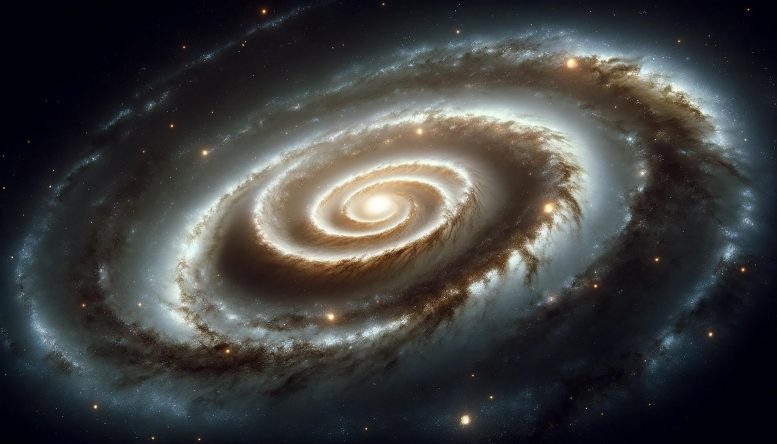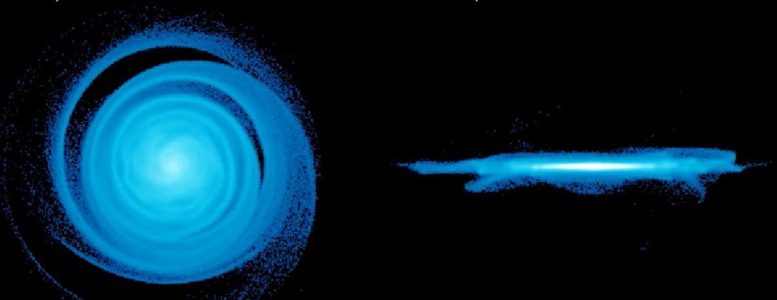
Scientists have discovered significant details about early galaxy formation by studying one of the oldest known spiral galaxies. Their findings, which include seismic wave patterns and a distinct bar structure in the galaxy, reveal the dynamic processes of star formation in the early universe. Credit: SciTechDaily.com
Research on an ancient spiral galaxy reveals crucial insights into early galaxy formation, highlighting rapid star formation and unique structural features compared to contemporary galaxies.
A new snapshot of an ancient, far-off galaxy could help scientists understand how it formed and the origins of our own Milky Way.
At more than 12 billion years old, BRI 1335-0417 is the oldest and furthest known spiral galaxy in the Universe.
Lead author Dr. Takafumi Tsukui said a state-of-the-art telescope called ALMA allowed them to look at this ancient galaxy in much greater detail.
“Specifically, we were interested in how gas was moving into and throughout the galaxy,” Dr. Tsukui said.
“Gas is a key ingredient for forming stars and can give us important clues about how a galaxy is actually fueling its star formation.”

Illustration of a galaxy disk being disturbed. Credit: Jonathan Bland-Hawthorn and Thorsten Tepper-Garcia/University of Sydney
Unveiling Galactic Motion and Structure
In this case, the researchers were able to not only capture the motion of the gas around BRI 1335-0417, but also reveal a seismic wave forming – a first in this type of early galaxy.
The galaxy’s disk, a flattened mass of rotating stars, gas, and dust, moves in a way not dissimilar to ripples spreading on a pond after a stone is thrown in.
This new data means we now know more about how the galaxy formed.
“The vertically oscillating motion of the disk is due to an external source, either from new gas streaming into the galaxy or by coming into contact with other smaller galaxies,” Dr. Tsukui said.
“Both possibilities would bombard the galaxy with new fuel for star formation.
“Additionally, our study revealed a bar-like structure in the disk. Galactic bars can disrupt gas and transport it toward the galaxy’s center. The bar discovered in BRI 1335-0417 is the most distant known structure of this kind.
“Together, these results show the dynamic growth of a young galaxy.”
Simulation showing the formation of a spiral galaxy. Credit: Takaaki Takeda, Sorahiko Nukatani, Takayuki R. Saitoh, 4D2U Project, National Astronomical Observatory of Japan (NAOJ)
A Glimpse Into the Past
Because BRI 1335-0417 is so far away, its light takes longer to reach Earth. The images seen through a telescope in the present day are a throwback to the galaxy’s early days — when the Universe was just 10 percent of its current age.
“Early galaxies have been found to form stars at a much faster rate than modern galaxies. This is true for BRI 1335-0417, which, despite having a similar mass to our Milky Way, forms stars at rate a few hundred times faster,” co-author Associate Professor Emily Wisnioski said.
“We wanted to understand how gas is supplied to keep up with this rapid rate of star formation.
The Role of Spiral Structures
“Spiral structures are rare in the early Universe, and exactly how they form also remains unknown. This study also gives us crucial information on the most likely scenarios.
“While it is impossible to observe the galaxy’s evolution directly, as our observations only give us a snapshot, computer simulations can help piece the story together.”
The study has been published in Monthly Notices of the Royal Astronomical Society.
Reference: “Detecting a disc bending wave in a barred-spiral galaxy at redshift 4.4” by Takafumi Tsukui, Emily Wisnioski, Joss Bland-Hawthorn, Yifan Mai, Satoru Iguchi, Junichi Baba and Ken Freeman, 23 November 2023, Monthly Notices of the Royal Astronomical Society.
DOI: 10.1093/mnras/stad3588
The ALMA (Atacama Large Millimeter/submillimeter Array) observatory, part of the European Southern Observatory (ESO), is comprised of 66 antennas that observe a single galaxy in unison. The data from each antenna are combined to create a single image of the galaxy using a supercomputer. This observatory played a pivotal role in the study.









Profile seems to be showing two wave-cycles of a “galactic quantum wavelet” effect forming a sort of target pattern in the overall morphology, imo.
btw, I remember joining a website over 20 years ago to post my ideas supporting the related notion that spiral galaxy evolution goes back much further than the experts were thinking, and boy did they get snarky fast. It’s pile-on and then gripe to queen mum with a rent-seeking organ-grinder puppet in a monkey suit at any response in-kind. I ended up getting kicked off tout-suite. Pretty sure it was my first shot at fizzorg. The 2nd try involved a wait of about 15 years, only to find they’re all still as happily and religiously inbred and drunk as ever.
Hi
Happy new year 2024
Happy new year
I think the term for a galaxy in the early universe would be early.
I might even call ita young galaxy. It cant be more than a billion years old can it?
Experience and observation has always given insight, the work I have been part of in my younger age was in the building of bonding metals and welding 20yrs approximately, mainly the torch cutting of bimetallic metals, what observed during that time has shown when high temperature molten metal falls to a concrete surface or the spatter from welding came into contact with the concrete a cold inert surface the action of the molten metal acts in ways that is seen in our universe as what I compare to the different types of galaxies a hot molten plasma contacting a cold inert environment the spatter would pop,swirl, sizel, and burn out to a slag, the slag was void of magnetic effect and had no value left for reaction, just a short explanation of my full experiences of that time, if the universe was the advent of the singularity the sheer difference of the heat created and the cold of the expanse would detonate the plasma from the singularity.